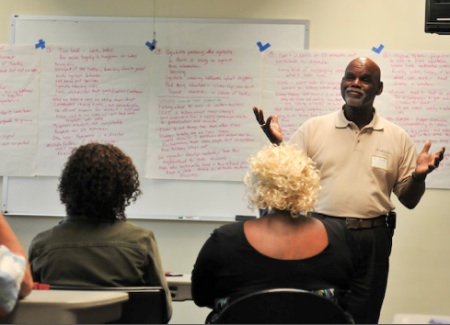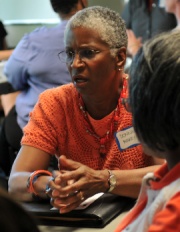
(Photos © J. Maus)
PBOT hosted the second of two “brainstorming sessions” for their North Williams Traffic Safety Operations Project last night. As I reported last week, the agenda for the first meeting — to come up with ideas for a new outreach campaign to improve behavior on Williams — was scrapped when the conversation turned to the history of institutional racism and gentrification in the neighborhoods around the Williams corridor.
In the week since that meeting, these issues have gained wider attention. Oregon Public Broadcasting devoted part of its Think Out Loud radio show to the topic and just yesterday, Mayor Sam Adams weighed in with his thoughts. Here on BikePortland, comments have flowed in from a variety of perspectives.

|
“People are having the opportunity to be heard.” |
The simple fact that people have had the ability to weigh in and have their voices heard has helped to move the discussion forward and has helped soothe some of the anger.
With the discussion much more evolved, PBOT was prepared for the meeting last night. They did not come with a pre-set agenda and instead of the staff member and consultant who have led the project since January, a facilitator was brought in to direct the meeting.
The facilitator was Lee Moore, a noted African-American civic leader who was born in Vanport (a public housing development built for (mostly African-American) shipyard workers that was completely destroyed in a flood in 1948) and is now the Chairman of the Housing Authority of Portland.
“After last week, I was so disheartened; And I feel so positive about it today.”
— Michelle DePass
Others in the room last night (that weren’t at the first meeting) included a transportation policy adviser for Mayor Sam Adams, a representative from the Bicycle Transportation Alliance, a reporter and photographer from The Oregonian, Community Cycling Center Executive Director Alison Graves, and author and CEO of Alta Planning and Design Mia Birk.
Moore was a brilliant choice by PBOT. He has experienced gentrification and displacement of communities both personally and in his role with the Housing Authority. With his warm, charismatic tone, he shared with the crowd last night that the conversation that has flared up around Williams wasn’t unique to North Portland — it has happened all over the city for decades.
“What I see happening here,” Moore said, “Is an opportunity to say, ‘We’re going to have bike paths, we need to be able to create alternative forms of transportation… but how do we do that in a way that keeps communities whole?… How do we do this in a way that is respectful, responsive to the needs of the community? How do we have this discussion so that all of our needs get met?'”
Moore made it clear, as did the letter from Adams, that larger issues of social justice and gentrification aren’t likely to be solved quickly or within the confines of this specific project process.
One of the announcements made last night is that PBOT has committed the resources to have a larger, public event about the community concerns. That event is likely to happen in September.
PBOT project manager Ellen Vanderslice also made it clear last night that the Williams project is moving forward (there’s a Stakeholder Advisory Committee meeting next Tuesday (8/2). When one woman in the crowd wondered why the City wanted to make Williams better for bicycling — “What you did on Vancouver [widening the bike lane and removing one lane] is horrible,” she yelled, “Now you want to do it on Williams Avenue… Why can’t bikes ride on sidestreets?!” — Vanderslice stood up for the project.
“Williams is the only street that actually goes through and that doesn’t have a big hill on it… Bicyclists don’t want to tackle a big hill… Because it’s such an attractive connector and because inner northeast Portland has the highest bicycle ridership in the City, it’s actually become a different situation now. That’s what got the City interested in this project… We’re looking at Williams because we now have enough people riding on that there are some issues from a safety point of view.”
Further momentum for the project moving forward came from the same local residents who have shared concerns about the racial equity issues.
Donna Maxey, whose comment about the project I published yesterday (she said she found the comments “very interesting”), complimented PBOT for hitting pause on the project.
“I would like to compliment them that they were wise enough to stop the process and do this; and I think we’ll have a much better solution to the problem since we’re doing that… People are having the opportunity to be heard.”
Maxey also said that, “No one’s trying to turn this into a racial issue.”
That’s an important statement. While the specter of a racist history has risen around this project, it became clear last night that many people in the community feel the traffic problems — many of which revolve around a simple lack of respect for others — are paramount and that the City should not put a solution to them on hold.
Maxey also shared an idea on how to educate new residents and others who aren’t familiar with the history of Williams Avenue. The City could install signposts with a number to call that would have a pre-recorded, first-person account of something that happened at the location of the sign. “It provides a link to the past,” she said, “People don’t want, what used to be there life, to be forgotten.”

Deborah Leopold Hutchins, founder of the Sistahs Weekend Cyclers group and a member of the project’s Stakeholder Advisory Committee, was first to approach PBOT staff with concerns about a lack of representation by African-Americans.
“While [project consultant] Michelle [Poyourow] and Ellen [Vanderslice] tried their best at getting a diverse group and getting out to the community, they recognized they could have done better.”
Also appreciative of PBOT’s attention to her concerns, Leopold Hutchins made it clear she wants the project to move forward; albeit with more engagement from people in the community. She implored the crowd last night to bring friends and neighbors to future meetings and get more people involved in the process.
“We’re not going to stop this immediately,” Leopold Hutchins said, “we’ve got to move forward, that’s my opinion.”
Leopold Hutchins said she’d love to ride on Williams with her ‘Sistahs’ group, but that she avoids it because it’s unsafe. “Until we can get Williams safe,” she said, “we’re not going to ride on it. I think we need to move forward, we need to get the community involved and then we need to get this process resolved.”
The woman who first brought up racial concerns at the meeting last week, Michelle DePass, also had positive words for the City last night. DePass said she appreciates that the City “took a step back” and she urged planners to keep the concept of “development, or gentrification, without displacement” in mind.
“After last week, I was so disheartened,” she shared, “And I feel so positive about it today.”
DePass also brought up a theme that was repeated several times last night and also was in Mayor Adams’ letter; the idea that the process PBOT has taken on this project serve as a model for planning processes in the future.
“We have an opportunity to make a model of planning without displacement,” DePass said, “You don’t have to hurt anybody by the policies we adopt at the City level.”
While there was a lot of laughter and a feeling of positive appreciation last night, anger was still present.
One African-American woman told of a near-physical altercation she had with a woman on a bicycle that she felt was highly disrespectful and uncalled for. Another man said he’s concerned that more bicycling on Williams will just mean more rowdy people in bars. “We’re bringing Bohemia to northeast Portland,” he said. There were also several calls for a licensing or identification system for people on bicycles that could also come with a new bicycle user fee to pay for new infrastructure.
One young man felt economic justice was they key issue:
“We’re going to spend hundreds of millions of dollars on bikes; every kid is not getting food at school, we’re laying off teachers… We all know that if certain people didn’t bike a lot that had a lot of power, we wouldn’t be having this discussion at all. They want to market Portland as a cool bike city; fine, but don’t do it on the backs of everyone else. We don’t have the money for all this B.S. We need to feed kids, educate kids, take care of people’s health care and take care of stuff that really matters.”
That comment exemplifies the wide-ranging and open discussion that was heard last night.
PBOT now seems poised — and has community backing — to continue both the social justice issues and the safety project. While the project process won’t ignore the history of the neighborhood (I think that’s impossible given everything we’ve been through), that history and the ongoing concerns about racism and gentrification will be given the larger forum they deserve. There is also talk about having two project committees, one for the social issues, the other for the street engineering and safety improvements discussion.
Anything can happen from here, but after last night it seems many people are feeling much better about this project. The issues that have been raised are complex and important, and racism is not territory PBOT usually wades into in their planning efforts. Lee Moore shared one reason why.
“One reason no one wants to talk about race is that diversity is messy,” said Moore in his closing remarks, “it’s a work in progress and something we never get done… and cyclists are another form of diversity.”
— For background on this project, browse BikePortland’s previous coverage.

